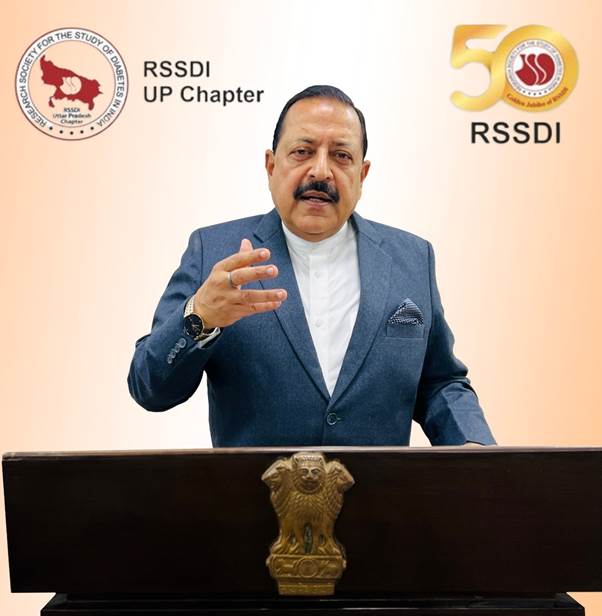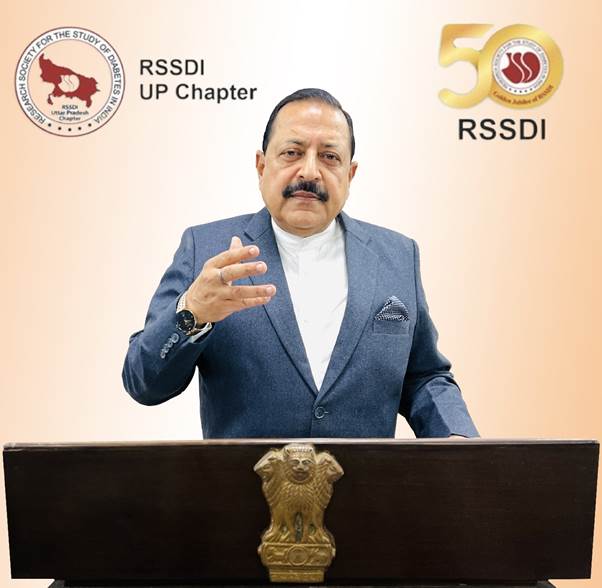Union Minister Dr Jitendra Singh, who is also a Professor of Medicine and a renowned Diabetologist, today said the spread of Type 2 Diabetes Mellitus is assuming epidemic proportions in India. Earlier this disease was confined to the affluent and in cities, but now its prevalence in rural areas is alarming, he said.
The Union Minister of State (Independent Charge) Science & Technology; MoS PMO, Personnel, Public Grievances, Pensions, Space and Atomic Energy was addressing the gathering after launching the Rural Diabetes Prevention & Control Campaign in village Purana Ramnagar of Varanasi district, a Village Adoption Program under the aegis of Research Society for Study of Diabetes in India (RSSDI) – Uttar Pradesh Chapter.

Terming the fast spread of Diabetes in the villages as a matter of grave concern, Dr Jitendra Singh said this has prompted a mass campaign for prevention of the disease in rural areas. “It was found most appropriate to make a beginning from the auspicious city of ancient and holy place of Varanasi,” he said.
The disease, hitherto identified as afflicting mostly the rich and elite due to their sedentary lifestyle and a phenomenon prevalent largely in cities, Dr Jitendra Singh said, the probable causes of its upsurge in rural India is a result of commonality of eating habits such as rising penchant for fast foods, more automation in agriculture and a resultant lack of physical activity. Lauding the efforts of RSSDI for taking this initiative towards diabetes prevention and management in rural India, he applauded the efforts quoting ICMR-INDIAB Study which says UP has 18% of its population in pre-diabetes stage.

“Such a large population, on the verge of being diabetic, can only be prevented if we start working for prevention in villages in the vicinity of big cities & progressing fast to urbanization. The idea of choosing Ramnagar for this initiative seems appropriate,” he said. Dr Jitendra Singh also appreciated the efforts done by RSSDI UP Chapter by adopting four villages in Barabanki in 2019 where people’s lives are better and diabetes control is improved.
“This encourages us to continue efforts in the same direction, in fact in more intensive manner,” he said. Dr Jitendra Singh said, over the last two decades, India has seen a surge in Type 2 Diabetes Mellitus, which has now acquired pan-Indian proportions. He said, Type 2 Diabetes, which was till two decades ago prevalent mostly in South India, is today equally rampant in North India and at the same time, it has also moved from metros, cities and urban areas to rural hinterland.
Quoting from the Indian Council of Medical Research Guidelines, Dr Jitendra Singh said, the past three decades witnessed a 150 per cent increase in the number of people with diabetes in the country. He said, the main concern is the progressive lowering of the age at which Type 2 Diabetes is being diagnosed, with the disease prevalence becoming apparent in the age group of 25-34 years in both urban and rural areas.
Dr Jitendra Singh noted that the Central Government is working at different levels to meet this challenge like, for example, free blood sugar testing campaign at national level, general health insurance policy, Ayushman Bharat, Wellness Clinics, kidney dialysis facility in all district government hospitals, promotion of Yoga, etc. But, at the same time, the non-governmental agencies and the civil society in general also have to take a call, he said. Dr Jitendra Singh said, lifestyle management plays an essential role in managing Type 2 Diabetes, and understanding the effect of diet and physical activity on glycemia is essential for optimal management of the disease.
Dr Jitendra Singh said, this is also important because the Indian phenotype is different from the Westerners and the genetic preponderance is also quite different. As a result, the pathogenesis and progress of Type 2 Diabetes Mellitus and other related metabolic disorders is not the same as in the Western populations. Citing research evidence, Dr Jitendra Singh said it has now been proven beyond doubt that Indian origin diaspora living in European countries for several generations still continue to have higher preponderance to develop Type 2 Diabetes Mellitus even though they were no longer living in India and the environmental conditions they are living in is different.
Referring to some of the important risk factors prevalent in Indians, Dr Jitendra Singh said that our central obesity profile is also different from others. For example, in India, prevalence of central obesity is high and almost equal in both males and females whereas in the Western population, the individual may be apparently looking obese but has general visceral fat, he said. Dr Jitendra Singh said, it’s heartening to note that new breakthroughs are being reported in the diagnosis and treatment of the “Killer Number One Disease of our time globally.”
Dr Jitendra Singh said that in times to come, India is all set to lead the Diabetes research in the world. “India has a huge resource pool of patients with different manifestations of diseases at different stages and at the same time there is no dearth of calibre, capacity and acumen on the part of our researchers. It is therefore the right time to generate as much Indian data as possible because the goal should be to develop Indian treatment regimens for Indian patients, Indian solutions for Indian problems,” he said.
Referring to PM Modi’s support to indigenous medical research, Dr Jitendra Singh said that even during the pre-COVID era, it had been proven with evidence that in the treatment of non-communicable diseases, like for example, Diabetes-Mellitus, the dose of insulin or oral anti-diabetic drugs could be brought down with the adjuvant practice of certain Yoga Asana and lifestyle modifications available in Naturopathy.
“New India will become Atmanirbhar in healthcare only by integrating various sciences and domains of medicine, going beyond Allopathy and synergising oriental alternatives like AYUSH, Yoga etc as well,” he said. Dr Jitendra Singh said that traditional millets diet is beneficial in diabetes, obesity and host of other disorders. Millets are rich in essential vitamins, minerals, protein and fibre, he said.
Dr Jitendra Singh said, after Prime Minister Narendra Modi popularised Yoga globally, it’s now time to do so for Millets. He said, 10 of the 12 known types of millets are grown in India, which consist of complex carbohydrates, slow to digest and hence low glycemic index beneficial for blood sugar levels.
Dr Jitendra Singh said the prevention of diabetes is not only our duty towards healthcare but also our duty towards nation building because this is a country with 70% population below the age of 40 and the youth of today are going to be the prime citizens of Viksit Bharat @ 2047. “A large section of our population still resides in the villages, comprising majority of farmers and farming community. We cannot afford to let their energy go waste in incapacitating complications occurring as a result of Type 2 Diabetes and other related disorders,” he said.
Lauding Prime Minister Shri Narendra Modi for the high priority given to healthcare, the Minister said that it was because of the personal interest and intervention of Prime Minister Modi that within two years, India not only managed the Covid pandemic successfully better than much smaller countries, but also succeeded in coming out with a DNA vaccine and providing it to the other countries as well.
“The roadmap for the next 25 years of Amrit Kal will witness the ascent of India as a front-ranking nation in the world in terms of best healthcare system,” he said. On the occasion, Dr Jitendra Singh felicitated Padamshri Prof Kamalakar Tripathi and Ritesh Pal, Gram Pradhan (Village Head) of Purana Ramnagar on this occasion.

